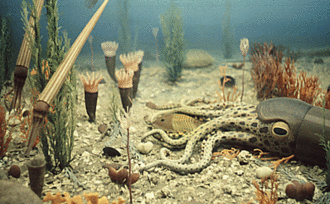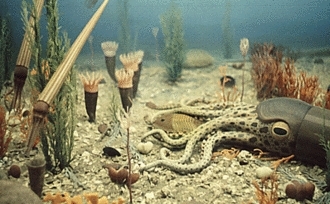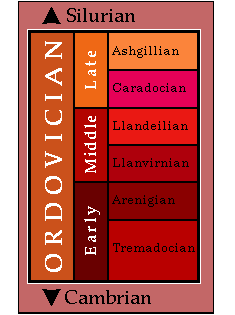Ordovician (Biodiversity)
Contents
- 1 Ordovician
- 1.1 Introduction The Ordovician period began approximately 490 million years ago, after the end of the Cambrian; the Ordovician ended around 443 million years ago, with the beginning of the Silurian. At this time (Ordovician) , the area north of the tropics was almost entirely ocean, and most of the world's land was collected into the southern super-continent Gondwana. Throughout the Ordovician, Gondwana shifted towards the South Pole and much of it was submerged under the world's oceans.
- 1.2 Subdivisions of the Ordovician
- 1.3 Stratigraphy of the Ordovician
- 1.4 Life of the Ordovician
- 1.5 Tectonics and paleoclimate of the Ordovician
- 1.6 Further reading
Ordovician
This article on the Ordovician Period was written by Christina Avildsen, Jennifer Bie, Chirag Patel and Brie Sarvis.
Introduction The Ordovician period began approximately 490 million years ago, after the end of the Cambrian; the Ordovician ended around 443 million years ago, with the beginning of the Silurian. At this time (Ordovician) , the area north of the tropics was almost entirely ocean, and most of the world's land was collected into the southern super-continent Gondwana. Throughout the Ordovician, Gondwana shifted towards the South Pole and much of it was submerged under the world's oceans.
The Ordovician is best known for the presence of its diverse marine invertebrates, including graptolites, trilobites, brachiopods, and the conodonts (early vertebrates). A typical marine community consisted of these animals, plus red and green algae, primitive fish, cephalopods, corals, crinoids, and gastropods. More recently, there has been found evidence of tetrahedral spores that are similar to those of primitive land plants, suggesting that plants invaded the land during the Ordovician.
From the Early to Middle Ordovician, the earth experienced a milder climate in which the weather was warm and the atmosphere (Atmosphere layers) contained a lot of moisture. However, when Gondwana finally settled on the South Pole during the Late Ordovician, massive glaciers formed causing shallow seas to drain and sea levels to drop. This likely caused the mass extinctions that characterize the end of the Ordovician, in which 60% of all marine invertebrate genera and 25% of all families became extinct.
Subdivisions of the Ordovician
The chart depicted illustrates the major subdivisions of the Ordovician Period. This chart is mapped, to allow the reader to travel back to the Cambrian or forward to the Silurian. In terms of evolutionary ecology the Ordovician occurs near the early part of the Edenic Period, a time interval of long duration, during which there was a gradual increase in the number of Earth's living organisms, with a very modest number of species extinctions and a relatively stable average background extinction rate.
The Ordovician Period is part of the Paleozoic Era.
Stratigraphy of the Ordovician
The Ordovician was named by the British geologist Charles Lapworth in 1879. He took the name from an ancient Celtic tribe, the Ordovices, renowned for its resistance to Roman domination. The epochs and series of the Ordovician each have a type location in Britain, where their characteristic faunas may be found. The age of the Ordovician boundaries were determined using potassium-argon and uranimum radiometric dating. Graptolites, extinct planktonic organisms, are most often used to correlate Ordovician strata.
The boundary between the Cambrian and the Ordovician is marked by the appearance of planktic dictyonemid graptolites. The boundary between the Ordovician and the Silurian has been designated as the base of the Parakidograptus acuminatus graptolite zone by international agreement. Dobs Linn, near Moffat, in southern Scotland is the type locality for that boundary. There, black graptolite-bearing shales are exposed.
Life of the Ordovician
Ordovician strata are characterized by numerous and diverse trilobites and conodonts (phosphatic fossils with a tooth-like appearance) found in sequences of shale, limestone, dolostone, and sandstone. In addition, blastoids, bryozoans, corals, crinoids, as well as many kinds of brachiopods, snails, clams, and cephalopods appeared for the first time in the geologic record in tropical Ordovician environments. Remains of ostraderms (jawless, armored fish) from Ordovician rocks comprise some of the oldest vertebrate fossils.
Despite the appearance of coral fossils during this time, reef ecosystems continued to be dominated by algae and sponges, and in some cases by bryozoans. However, there apparently were also periods of complete global reef collapse due to global disturbances.
The major global patterns of life underwent tremendous change during the Ordovician. New platform trilobites appeared. Perhaps this was because of the peak separation of continental plates at this time, and the reresulting vicariant distribution of trilobite groups. In addition, the first planktonic graptolites evolved, though some species of graptolites became extinct.
 Source: Univ Calif. Museum Paleontology
Source: Univ Calif. Museum Paleontology In the Arenig, the diversity of conodonts decreased in the North Atlantic Realm, but new lineages appeared in other regions. Seven major conodont lineages went extinct, but were replaced by nine new lineages that resulted from a major evolutionary radiation. These lineages included many new and morphologically different taxa. Sea level transgression persisted causing the drowning of almost the entire Gondwana craton. By this time, conodonts had reached their peak development.
Although fragments of vertebrate bone, and even some soft-bodied vertebrate relatives, are now known from the Cambrian, the Ordovician is marked by the appearance of the oldest bony vertebrates whose appearance is completely known. These were jawless, armored fish informally called ostracoderms, but more correctly placed in the taxon Pteraspidomorphi. Typical Ordovician fish had large bony shields on the head, small, rod-shaped or platelike scales covering the tail, and a slitlike mouth at the anterior end of the animal. Such fossils come from nearshore marine strata of Ordovician age in Australia, South America, and western North America.
Perhaps the most eventful occurrence of the Ordovician was the colonization of the land. Remains of early terrestrial arthropods are known from this time, as are microssils of the cells, cuticle, and spores of early land plants.
Tectonics and paleoclimate of the Ordovician
During the Ordovician, most of the world's land was collected together in the super-continent Gondwana. Gondwana consisted of Southern Europe, Africa, South America, Antarctica, and Australia. Throughout the Ordovician, Gondwana moved towards the South Pole where it finally came to rest at the end of this period. In the Early Ordovician, North America roughly straddled the equator and almost all of that continent lay underwater. However, by the Middle Ordovician North America became land with a karst topography on exposed carbonate rocks that developed. Taconica, a tectonic highland, formed along the margin of eastern North America. Also at this time, Western and Central Europe were separated and located in the Southern Tropics; Europe shifted towards North America from higher to lower latitudes.
During the Middle Ordovician, uplifts took place in most of the areas that had been under shallow shelf seas. These uplifts are seen as the precursor to glaciation. Also during the Middle Ordovician, latitudinal plate motions appear to have taken place, including the northward drift of the Baltoscandian Plate (northern Europe). Increased sea floor spreading and ridge activity accompanied by volcanic activity occurred in the Llanvirnian. Ocean currents changed as a result of lateral continental plate motions causing the opening of the Atlantic ocean. Sea levels underwent regression and transgression globally. Because of sea level transgression, flooding of the Gondwana craton occurred as well as regional drowning which caused carbonate sedimentation to cease.
During the Ashgillian (Late Ordovician), a major glaciation centered in Africa occurred. Because of this global disturbance, oxygenation, ocean erosion, and a severe decline in sea level resulted. In addition, aggressive circulation, then shrinking, of tropical belts also resulted. This glaciation caused a dramatic regression of ocean waters which drained nearly all craton platforms. More specifically, this glaciation contributed to ecological disruption and mass extinctions. Nearly all conodonts disappeared in the North Atlantic Realm while only certain lineages became extinct in the Midcontinental Realm. Asaphoid larvae-bearing trilobites, echinoderms, brachiopods, bryozoans, graptolites, and chitinozoans also became extinct. The Atlantic Ocean closed as Europe moved towards North America. Climatic fluctuations were extreme as glaciation continued and became more extensive. Cold climates with floating marine ice developed as the maximum glaciation was reached.
Further reading
- Fossils of Kentucky website.
- Ordovician. Paleontology through Geologic Time site by Dr. Ron Blakey of Northern Arizona University.
- Ordovician Mass Extinction at the Hooper Virtual Paleontology Museum.
- Paleontology Portal.

